Dogs are known to have a strong sense of smell. But do you know that there are some breeds that excel in the sight department? These dogs are known as sighthounds. They excel in hunting and chasing animals. Instead of relying on their sense of smell, sighthounds use their agility, hawk-eye, and prey drive. So what is a sighthound dog and should you get one as a pet? In this post, we will take a look at this breed and who are suitable to own them.
What is a sighthound dog?
A sighthound dog is a hunting canine known for its excellent sight and speed. This is the reason why most sighthounds are thin and have long legs. Their lean bodies and flexible back allow them to chase after the target.
Although they have thin bodies, sighthounds have large lungs and heart, the same reason why they have deeper chests than most canines. This is due to the need for agility and endurance on long runs.
Aside from that, sighthound dogs are among the oldest breeds on the planet. Some sighthound breeds have been traced to at least 5,000 years back.
Who should get a sighthound dog?
Unlike other domesticated canines, living with a sighthound is a whole different experience. If you’re planning to get one of these dogs, you must know if it’s right for you.
First, sighthounds have an intense prey drive. Dog lovers who want to get a sighthound breed should have a yard where the pooch can roam around. Though some sighthound breeds can thrive in an apartment setting, it’s not usually an ideal place for most of this dog group.
Also, sighthounds are easily enticed by moving objects or even running kids. So if you have a toddler or smaller pets, you should think twice before adopting this breed.
Nevertheless, most sighthounds can be docile at home with proper training. They also love playing and can be great companions for older children. Also, they can live with other dogs, which makes them a great choice for multi-canine households. Still, you shouldn’t pair them with a toy dog as they might be the target of the sighthound’s predatory instincts.
What is a Sighthound Dog? 10 Breeds to Consider
1. Afghan Hound

Afghan Hounds are one of the quintessential sighthound dogs. They are known for their silky coat that makes them a favorite during dog shows.
The Afghan Hound came from Afghanistan where they were called Tazi and is considered as one of the oldest dog breeds.
Aspiring owners of this breed should be ready to deal with their strong predatory instincts as well as the tendency to explore the neighborhood. And although Afghan Hounds are fairly intelligent, they aren’t the easiest to train. Also, this doggo sheds a lot.
Overall, Afghan Hounds can be affectionate to their masters as well as older kids. They can also live with other dogs. However, you should be careful since this breed is aloof and watchful of strangers.
And guess what, Afghan Hounds can thrive in apartment living. Still, you should only get this breed if you’re already an experienced dog owner.
2. Saluki

Salukis are also known to be one of the oldest canine breeds. They were extremely fast runners and are quiet pets at home. And as second nature to a sighthound, this breed loves hunting, chewing things, and looking for a target. But unlike Afghan Hounds, Salukis are easier to train.
Take note that Salukis aren’t apartment dogs. They also need a headstrong owner who can impose strict rules at home. Although agile sprinters, they can be trained to be loyal and gentle pets at home. In fact, they do well with older kids and other canines.
If you want a sighthound that’s easy to groom and train, your best is a Saluki. They are also hardy pets with no strong predisposition to genetic defects.
3. Basenji
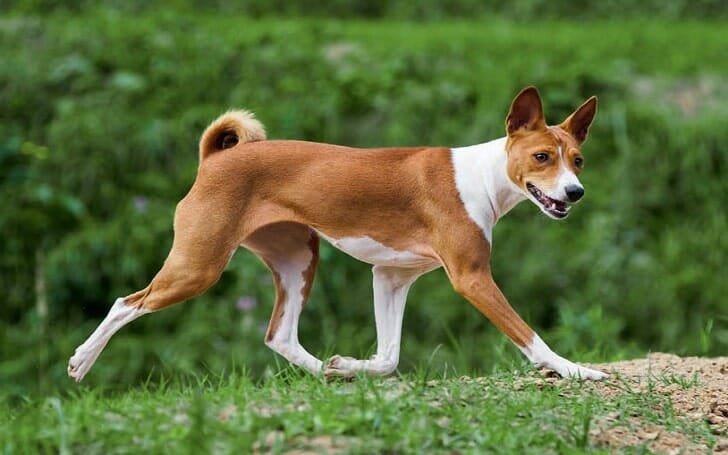
Widely known as the ‘barkless dog’, Basenjis are one of the excellent sighthounds. This doggo originated in Congo and was used both as a scenthound and a sighthound. So if you’re planning to get this breed, expect that it will exhibit these two distinctive skills.
Basenjis are dignified canines that are always in alert mode. They have intense prey drive, intelligence, and dedication to their task.
The good thing about Basenjis is they suit novice owners, not to mention that they can thrive in an apartment setting. They are also independent dogs who don’t mind being left alone for the day.
Most of all, Basenjis are sweethearts. They are friendly to everyone, even to young kids and strangers. However, this dog isn’t into a lot of playtimes. They prefer watching over the place.
4. Whippet
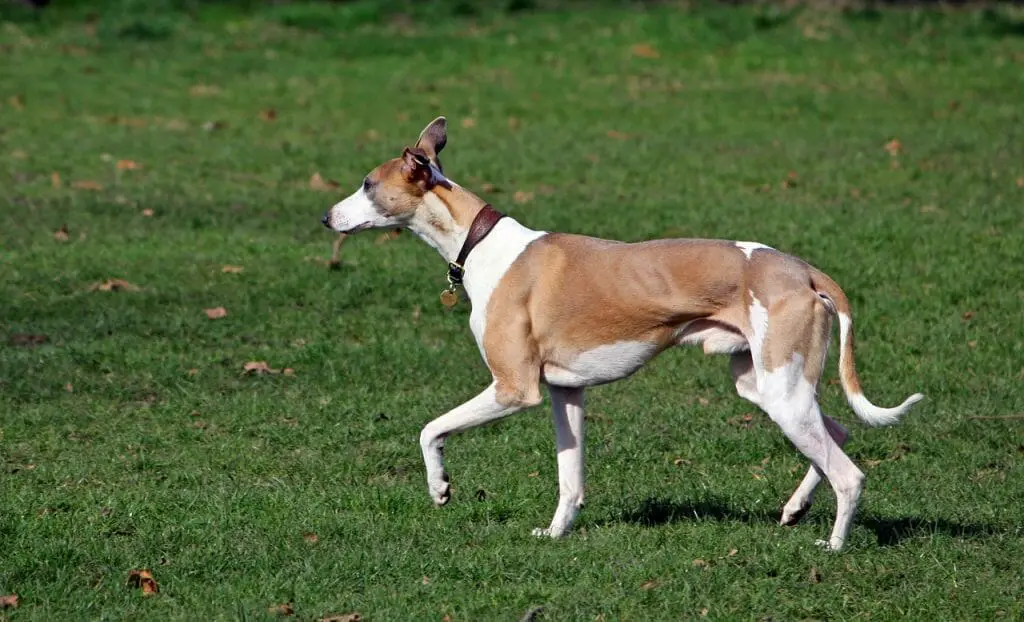
Whippets used to be best friends of poachers due to their incomparable speed and accuracy in hunting. This is the same reason why they are the top competitors in flyball, agility drills, and coursing. Aside from their job in the hunting field, they are also trained to be therapy dogs.
Whippets are lean and tall canines. Although their size may look intimidating for those living in apartments, they can actually thrive in the limited space. Whippets are also affectionate canines that will form a strong bond with the whole family. So if you’re thinking of getting a Whippet as a guard dog, you should think twice because this pooch will happily welcome a thief.
Overall, this breed is easy to train, though you’d have to deal with their intense energy level.
5. Azawakh
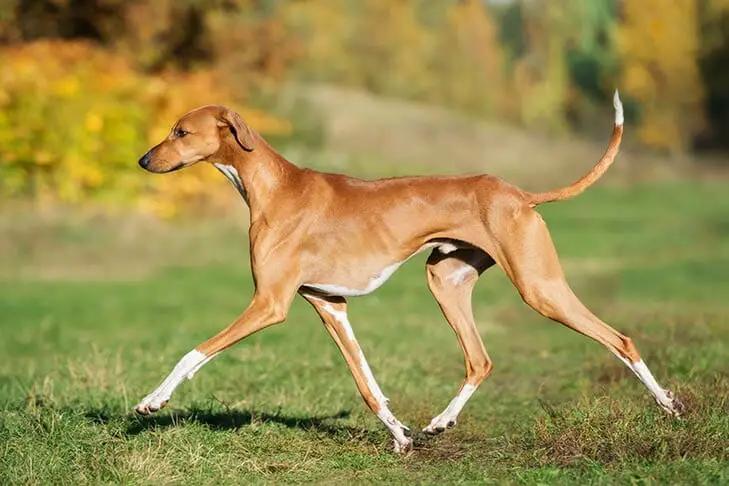
The Azawakh breed has similarities to the Basenji dog. It has a lean body and a watchful personality. Aside from that, Azawakhs can also thrive in apartment living and they are not big fans of playtime.
Unlike Basenjis, Azawakhs aren’t for the faint of heart. This sighthound isn’t the most affectionate bunch because they are less tolerant of kids, other dogs, and strangers. Their prey drive will reign if you fail to train them ahead.
The good thing with Azawakhs is that they are quiet dogs. They don’t like roaming around and prefers guarding their post. And since they are independent canines, they are a bit challenging to train. Nevertheless, they are less active than other sighthounds. Still, they require a lot of exercise, though their energy level is quite manageable.
6. Spanish Greyhound

Spanish Greyhounds, also known as Galgo Español, are highly athletic dogs with a quiet and seemingly mysterious personality. They form a strong bond with their families and people they see on a regular basis. Still, they have an air of aloofness to strangers.
Due to their intense energy, it’s important to exercise a Spanish Greyhound regularly. If you give them enough exercise during the day, this Greyhound breed will rest calmly on your feet during the night.
If trained and socialized during its early life, the Spanish Greyhound can live with other canines and even cats. However, avoid pets that are very small as it can trigger their hunting instincts.
Lastly, you should start training this breed as early as possible. By the time a Spanish Greyhound reaches six months, you’ll have a more stubborn dog to train.
7. Ibizan Hound
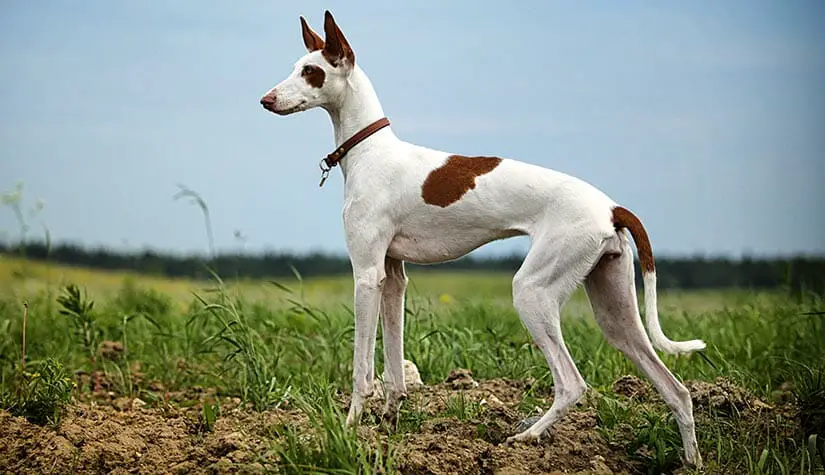
The Ibizan Hound came from the Balearic Island located in Ibiza, Spain – thus their name. They are a common sight on conformation, coursing, and agility competitions.
Although this dog may look imposing at times, they are one of the most affectionate among the sighthound group. They welcome everyone, even strangers and other dogs. And despite their intense energy level, they can be trained to adapt to an apartment setting.
If you’re planning to get an Ibizan Hound, you must know that this doggo hates being left alone for long hours. If you do so, they can be destructive chewers.
One distinctive feature of the Ibizan Hound is its large and erect ears. This gives them a strong sense of hearing, which makes them suitable as a watchdog. Once you see their ears twitching, it’s a sign that someone or something is approaching.
8. Irish Wolfhound
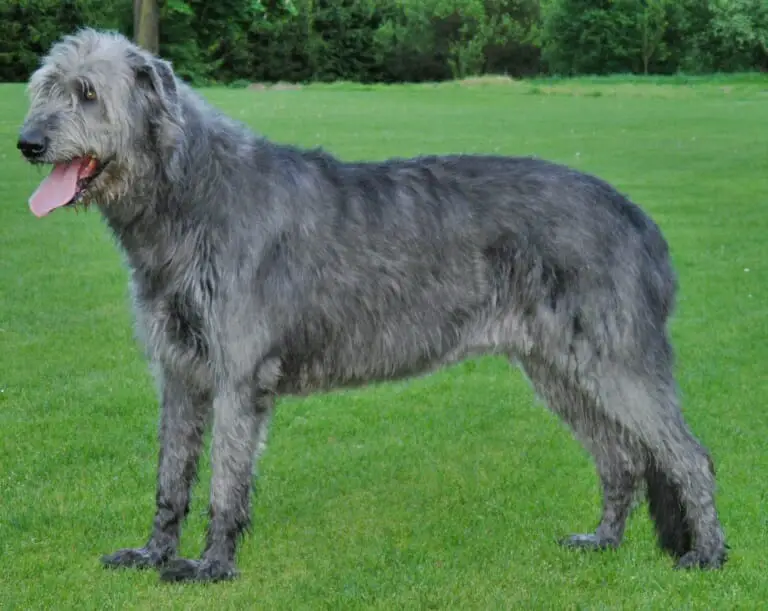
Unlike other sighthounds, the Irish Wolfhound had a unique first job. They were used during the war era to drag men out of their chariots and horses. Later on, they became hunting buddies for catching wolves, deer, and wild boar.
Nowadays, the Irish Wolfhound has found its way to domestic homes. This canine still retains its prey drive but it has less energy level than its cousins in the sighthound group. Still, this doggo will appreciate regular playtimes and walks.
If you’re looking for a very affectionate dog, Irish Wolfhounds won’t disappoint. This dog has a big heart for its family, including kids and other canines. Also, they suck as guard dogs because they wag their tails on strangers.
9. Borzoi
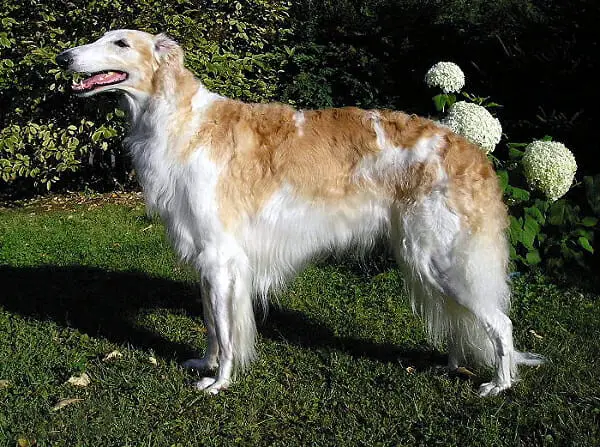
Like the Afghan Hound, Borzois have a silky and long coat. Still, they are fairly easy to groom and maintain. They are also hardy pets that aren’t prone to any major disease.
When it comes to domesticated life, Borzoi dogs can stay happy in an apartment setup. They are also affectionate dogs, though you should take caution when they are around kids. This breed can live with another dog, preferably the same size as them.
Also, if you’re looking for a guard dog, don’t expect Borzois to fit the bill. These are friendly dogs that will let a thief in.
Overall, this breed is a laidback dog in terms of energy level, exercise needs, and intensity.
10. Sloughi
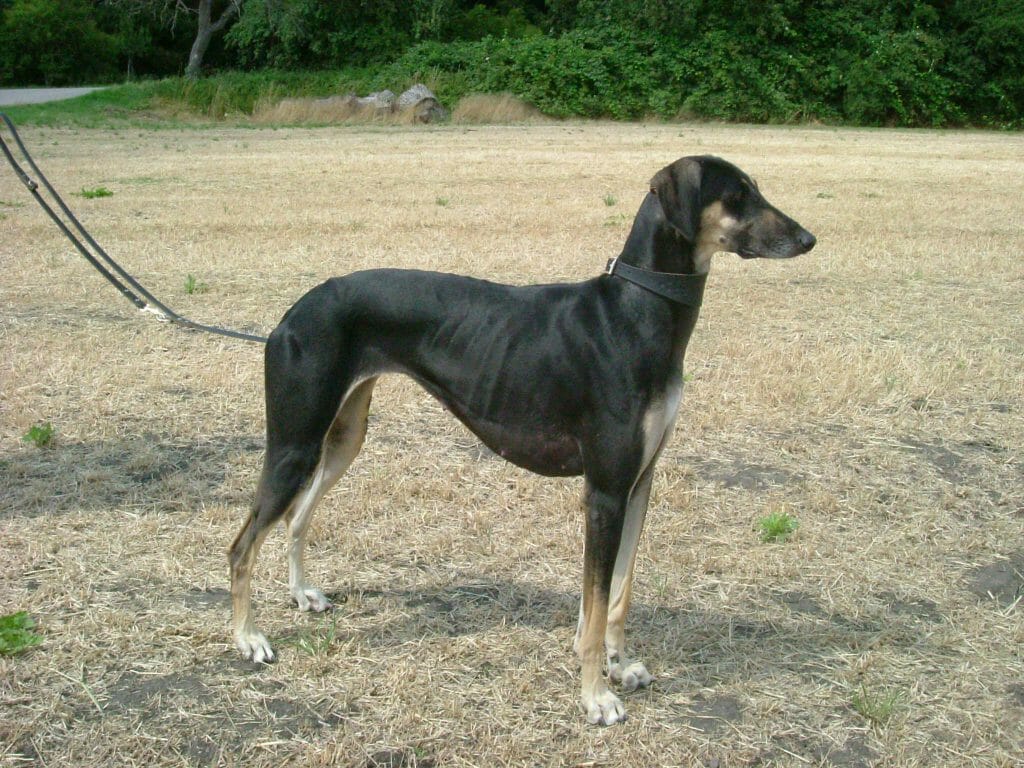
Last but not the least, we have the Sloughi breed. This dog has an ancient lineage and was nicknamed as the ‘Arabian Greyhound’. They used to be hunters in the North African desert where they catch gazelles, foxes, jackals, and wild pigs.
This canine can also thrive in apartment living, though they should be owned by experienced masters. Overall, Sloughis are affectionate dogs with a mild aloofness to strangers. But with a little playtime and some treats, they will easily give in.
Unlike Borzois, this breed has a very high energy level. They also require rigorous exercise every day with a moderate dose of playtime.
During training, you need to keep a strong hand with this breed. They can be headstrong and will try to go their own way.
Frequently Asked Questions
Q: Are Rhodesian Ridgebacks sighthounds?
A: Rhodesian Ridgeback isn’t classified as a full sighthound since it shares the characteristics of a sighthound and scenthound. Also, this breed also exhibits Mastiff characteristics, making it difficult to classify.
Q: How far can a sighthound see?
A: Sighthounds have better vision than other canines. In fact, Greyhound has a 270-degree vision and a line of sight that can see objects up to half a mile. Also, many sighthounds have a stereoscopic vision that allows them to hunt and follow moving objects.
Q: Do Whippets smell bad?
A: The best thing about Whippets is they don’t have the distinctive doggy odor that other canines have. It also has a thin coat that makes this breed very easy to groom.
Q: Can a sighthound dog be a family pet?
A: Yes! If you source the puppy from a responsible breed and train it properly, a sighthound can be an amazing pet. Just take note that sighthounds aren’t couch potatoes. You need to give them enough exercise and a yard where they can run around.
Q: How old should a sighthound pup start to hunt?
A: If you’re grooming your sighthound doggo to accompany you on your hunting hobby, the best time to send them on the field is around 8 to 11 months old. By this time, the dog has reached sexual and physical maturity. It’s also enough time to train the pooch.
Final words
So what is a sighthound dog? It’s a dog that excels in hunting through their eyes, rather than tracing scents. If trained and raised well, these agile doggos can be amazing pets. You should just mind the breed you’re getting to get as this dog group offers a variety of personalities.
Do you own a sighthound? How is it living with an athletic dog? Let us know below!
